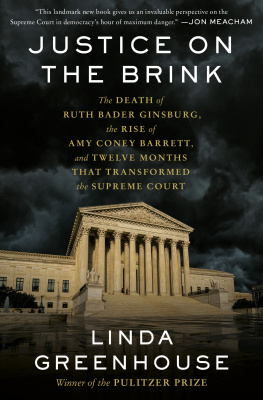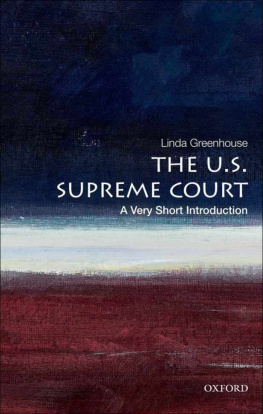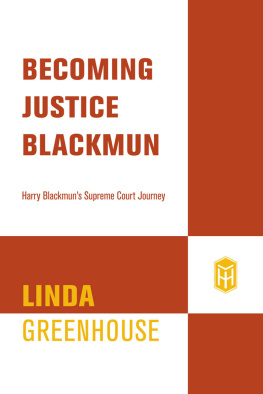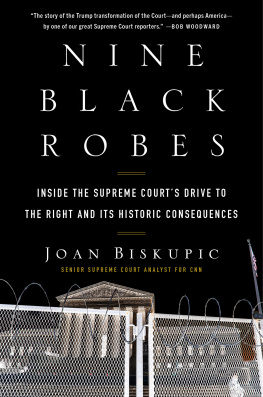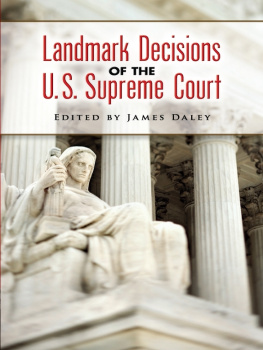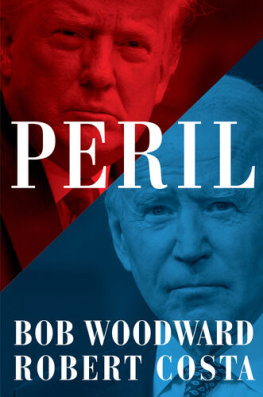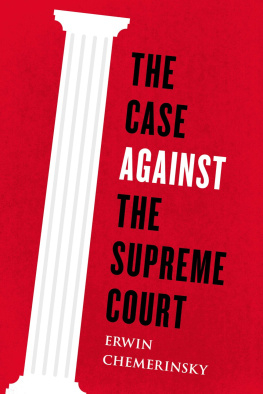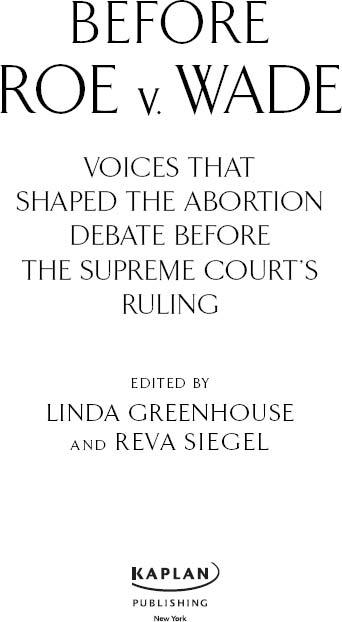TABLE OF CONTENTS
This books purpose is to recapture a time that is rapidly fading from memory. During the years before January 22, 1973, the day on which the Supreme Court decided Roe v. Wade and proclaimed that the Constitution protected a womans right to decide whether to bring a pregnancy to term, Americans conducted a vigorous debate about abortions morality and meaning. It is obvious today that the Supreme Courts decision did not end this debate. Neither, of course, did the Court start italthough public discussion of Roe v. Wade implies not infrequently that it did. By the spring of 1971, when the justices agreed to decide Roea case challenging the constitutionality of a nineteenth-century Texas law that prohibited all abortions except those necessary to save a womans lifethe legal pipeline was rapidly filling up with challenges to abortion laws from around the country.
By declaring unconstitutional laws that criminalized abortion in states across the country, the decision in Roe v. Wade also swept away much of the collective memory of what had gone before. Records of court cases that had taken years to build were now rendered irrelevant, and transcripts of testimony once painstakingly compiled were carelessly misfiled or discarded. And beyond the loss of paper records, the Supreme Court decision itself proved a distorting lens through which to look back on what had preceded it.
For example, the fact that neither women nor fetuses figured very prominently in Roe v. Wade makes it plausible to assume that feminist voices and right-to-life voices were simply missing, both from the arguments presented to the Supreme Court and from the public conversation. In fact, feminist and right-to-life positions were passionately expressed in public debate and in friend-of-the-court briefs filed in Roe. Yet, the Supreme Court issued a decision that appeared mainly responsive to the arguments of the medical community. In page after page, Roe reasoned from medical science, and in its main holding affirmed the autonomy of doctors to act in what they believed to be the best interest of their patients. The organized medical profession, which had spurred the criminalization of abortion a century earlier, had come only lately to view the hundreds of thousands of illegal abortions performed every year as a public health problem of urgent dimensions. The Court responded to these medical voiceswhich the justices heard through legal briefs and, more informally, through their reading and in their daily lives.
As this book demonstrates, doctors and public health advocates played an important role in setting the nation on the road to Roe, but so too did movements for human freedom. In the pages that follow, we trace how arguments for liberalizing abortion law in the name of public health gave way over time to claims of the womens movement seeking for women liberty, equality, and dignity: womens right to control their own bodies and lives; to have their voices and decisions treated with respect; and to participate as equals in private and public life. As the womens movement connected the abortion right to these larger claims of principle, the abortion conflict was constitutionalized. And these claims for repeal of laws criminalizing abortion in turn moved other Americans to appeal to widely held principles to defend the right to life of the unborn.
In this early period, the Catholic Church played a key role in helping mobilize its members to vote in defense of laws criminalizing abortion and, as importantly, to translate faith-based convictions about abortion into claims on secular forms of authority. Newly organized right-to-life chapters invoked secular sources of law, including the Declaration of Independence and international human rights treaties, to assert the claim that life in the womb was fully human life, as fully deserving of the states protection before birth as after. And right-to-life advocates appealed to the authority of science, incorporating newly available and widely published photographs of developing fetuses into their arguments for preserving the nineteenth-century statutes that criminalized abortion. The womens movement and the right-to-life movement shaped arguments made to the Court in Roe. But the Court responded to these arguments only indirectly. Perhaps these movement voices were sufficiently alien to the nine middle-aged-to-elderly meneight Protestants and one liberal Catholicwho decided Roe v. Wade that the Court simply could not hear them. Or, more likely, the justices, hearing support for abortions decriminalization from doctors, the bar, many religious leaders, and the rising tide of public opinion, chose to emphasize these mainstream sources of authority in Roe as offering a firmer basis for its decision than the nascent arguments of the feminist and right-to-life movement, which the justices may have heard as voices from the margins. Excerpts from the briefs filed to the Court are included in this book so that readers can sample for themselves the range of arguments that were being made for and against a right to abortion at the time the Court decided Roe.
This book does not offer a conventional history of a Supreme Court decision. It does not trace the various legal doctrines on which the Court drew in deciding Roe, nor does it follow litigation in the case from the filing of the complaint to its ultimate disposition in the Supreme Court. Numerous other sources tell the story of Roe v. Wade in narrative form, including David Garrows monumental Liberty and Sexuality: The Right to Privacy and the Making of Roe v. Wade (2nd edition, 1998) and Roe v Wade: The Abortion Rights Controvery in American History by 1998) and Roe v. Wade: The Abortion Rights Controversy in American History by E. H. Hull and Peter Charles Hoffer (2001). Through the documents collected here, our effort is rather to re-create the public conversations from which the case emerged. In the years before the Court decided Roe, what had Americans been doing and saying about abortion laws? With what other issues was abortion associated? How did these conversations change the meaning and social significance of abortion and alter views about the proper role for the government in regulating it?
Although both of us believe that women should be free to decide for themselves whether and when to bear children, this is not a work of advocacy. Our purpose in presenting original texts reflecting many points of view is to permit readers to come to their own informed conclusions about a consequential, but widely misunderstood, chapter in American social, political, and legal history. Indeed, while each of us has studied and written about the abortion issue for many years, every path we traveled in our search for relevant and representative documents enriched our own understanding of the period even as it raised new questions. We found ourselves on a journey of discovery that took us to public and private archives and that placed in our hands crumbling and long-forgotten legal documents retrieved from participants attics and basements. We heard the voices of women and menwell-known, little-known, and completely unknowncalling from across the years. It is a privilege to enable them to speak again in their own words in these pages. We benefitted from the generosity of those for whom the right to abortion has been a lifelong causeespecially those who challenged Connecticuts nineteenth-century abortion statute in the years before Roeas well as of two of the countrys most influential opponents of abortion reform, Phyllis Schlafly and Dr. Jack Willke. We are grateful to all those who permitted us to republish portions of their work. The result is a book that contains passionate appeals from contending movements, weaving together arguments that were once forged responsively.


